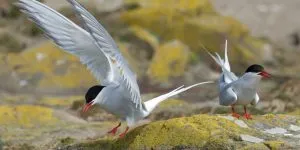Arctic terns, often referred to as ‘sea swallows’ are remarkably resilient creatures. The species is famous for its lengthy annual migration across the globe. In addition to this great feat, the arctic tern has many other fascinating characteristics.
In this article, we are going to cover 17 interesting facts about arctic terns.
1. Arctic terns undergo the longest migration of any animal on the planet.
The arctic tern annually flies across the globe from the northern hemisphere to the southern hemisphere and back. They do this to avoid harsh winters, and predation, and to benefit from the plentiful food supplies found in both hemispheres at different times of the year1 (source: National Wildlife Foundation).
In total, the species covers a distance of 45,000-60,000km (28,000-37,000 miles) every year2 (source: T. Alterstam, et al., Ecology and Evolution, Vol. 9, Issue 17, pp. 9511-9531, 2019).
This remarkable feat earns the arctic terns the title, ‘Champion of Migration’ as coined by Wells W. Cooke (the father of bird migration).
Find out more in our full guide to the Arctic Terns lengthy migration.
2. The arctic tern migrates in large groups.
During their annual migration, arctic terns will fly in large groups from northern polar regions such as Alaska or Iceland, over the Atlantic Ocean, and along the coast of Europe.
The congregation then divides at the equator.
Half of the congregation flies along the coast of Africa (named eastern terns) and the other half along the coast of South America (named western terns). The two groups coordinate their landing in Antarctica at nearly precisely the same time and place3 (source: C. Egevang, et al., Proceedings of the National Academy of Sciences, Vol. 107, Issue 5, pp. 2078-2081, 2010).
Interestingly, the species’ northbound migration does not involve such a distinct split at the equator. The route back to northern polar region is actually quite similar between large groups of arctic terns4 (source: T. Hromádková, et al., Marine Ecology Progress Series, Vol. 638, pp.1-12, 2020).

3. Arctic terns can fly at approximately 24 miles per hour.
This makes the arctic tern one of the fastest migratory birds on the planet.
Owing to the fact arctic terns have to travel further than any other species on the planet, they need to maintain a relatively high speed to fully benefit from the climate and resources of both the northern and southern hemispheres.
Arctic terns owe this speed to many physical, behavioral, and physiological characteristics including:
- Long and narrow wings
- Lightweight
- Slender build
- High-fat diet.
- Use of the wind systems5 (source: National Geographic)
4. Arctic terns can sleep while flying.
Arctic terns have to cover an immense distance in a relatively short period of time. They want to have as few stops as possible on their journey across the globe. Therefore, they have developed ways of eating and even sleeping while flying!
The arctic terns are able to do this by gliding rather than flapping their wings whilst covering vast migratory distances. The species is then carried by low-pressure wind systems.
The arctic terns’ wings and light weight are ideally suited to this type of flight.
As a result, they can fly up to 6,000 miles without stopping6 (source: C.P. F. Redfern and R.M. Bevan, International Journal of Avian Science, Vol. 162, Issue 2, pp.373-380, 2020).
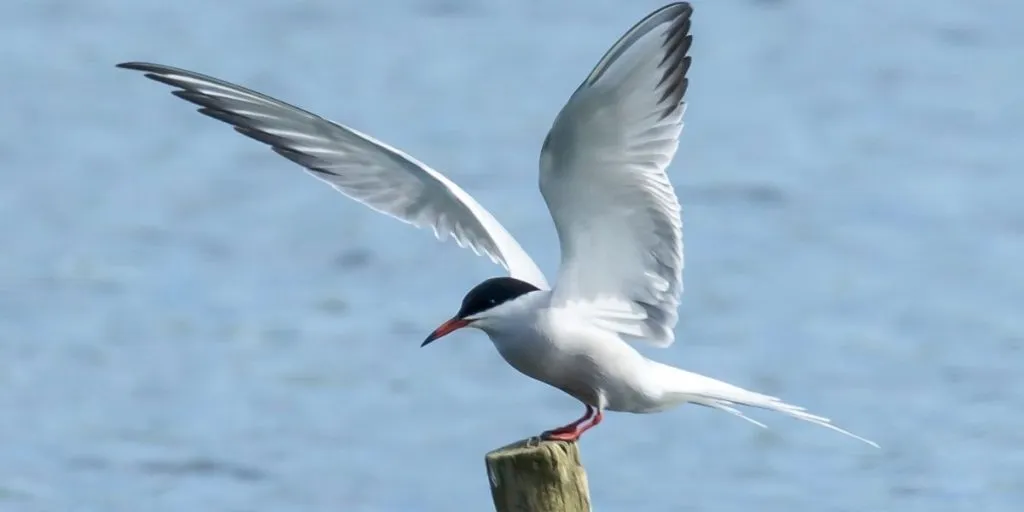
5. Arctic terns live in both the northern and southern polar regions of the globe.
The arctic terns’ migratory nature allows them to move between the northern and southern hemispheres to avoid harsh winters, and predation and to benefit from plentiful food resources found in different regions.
In the northern summer months, you can find artic terns nesting in areas such as Iceland and Alaska. These regions have plentiful food resources and relatively low predation. Alaska houses the largest breeding population of arctic terns.
During the southern summer, the species will then live in vast numbers on the northern edge of the Antarctic ice.
In these various regions, the species favors coastal habitats near bodies of water with plentiful supplies of fish and low predation7 (source: National Wildlife Foundation).
This vast geographic distribution of arctic terns can make their conservation and protection more difficult.
Find out more in our full guide to where arctic terns live.
6. Arctic terns mate for life
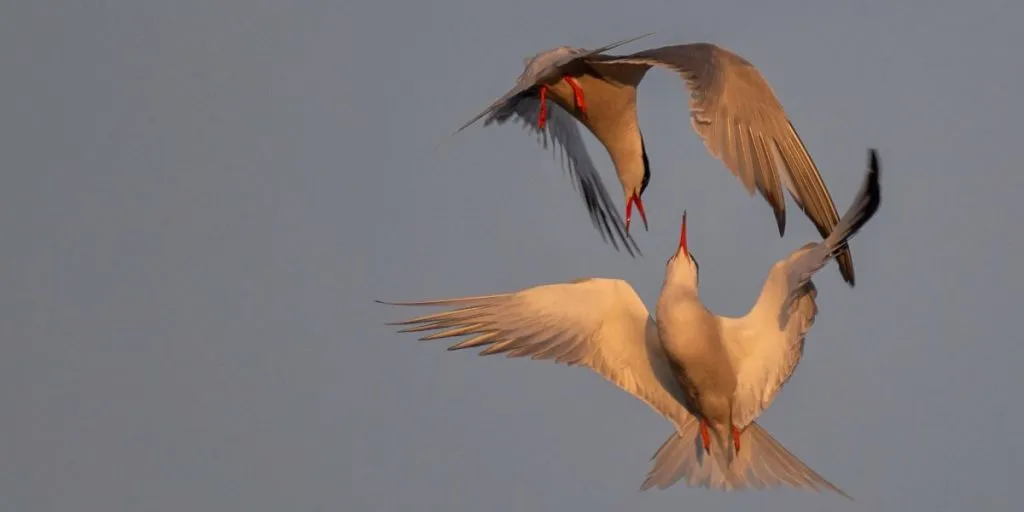
The arctic terns reach sexual maturity at ~3 years old but once reached, tend only to breed once every three years. This reduction in reproductive effort acts to increase migratory effort.
After breeding behaviors such as fish flight and feather displays take place, breeding pairs are established, often for life.
Breeding pairs also tend to return to the same breeding grounds in the northern polar regions for mating season. Both parents look after the 1-3 hatchlings per breeding cycle.
7. Arctic terns can live for ~34 years
The lifespan of an arctic tern is about 34 years. This is a relatively long lifespan for birds but is typical for other terns such as the sooty and white terns8 (source: M.K. Klimkiewicz, Longevity Records of North American Birds. 2008).
Due to their lengthy migration covering ~44,000-59,000 miles per year, the arctic tern can cover the distance between the earth and the moon over 3 times in their lifetime9 (source: C.Egevang, et al., Proceedings of the National Academy of Sciences, Vol. 107, No. 5, pp.2078–2081, 2010).
8. Arctic terns eat fish, insects, krill, mollusks, crab, and berries.
Arctic terns are generally carnivores however, they occasionally eat berries when other food sources are unavailable.
They have a relatively varied diet that allows the species to stay healthy and energized for migration every year.
- Fish is the artic terns’ most favored food source. They like to prey on small, schooling fish such as cod, smelt, and sand eels. They catch their prey by diving into the water at high speeds and using their beaks to grab the prey.
- Krill, crabs, and mollusks are all nutritionally beneficial for the arctic tern, providing fat, minerals, and energy to the bird for successful migrations.
- Insects tend to only be eaten in the northern summer months when they are in abundance.
Sadly, the arctic terns are bad at adjusting their diet when resources are low, therefore they could be vulnerable to the effects of climate change and overfishing altering fish populations in the future10 (source: F.Vigfúsdóttir, Drivers of productivity in a subarctic seabird: Arctic Terns in Iceland, 2012).
Learn more about the diet of an arctic tern and hunting behaviors in our guide to what arctic terns eat.
9. Arctic terns are kleptoparasites
Kleptoparasitism is when an animal steals resources from another animal, such as food.
The arctic terns often turn to this mischievous behavior for food.
They will startle other birds such as common terns or auks into abandoning or dropping their fish. The arctic tern will then swoop in and steal the food for themselves.
10. Arctic terns are one of the smallest members of the tern family
Arctic terns are one of the smallest members of the tern family. This could be because they travel a farther migratory distance than other terns11 (source: W.R. Meservey and W.R. Petersen,Massachusetts Breeding Bird Atlas, 2003). Their lightweight nature allows them to be carried by the wind to avoid huge losses of energy.
Arctic terns are 28-39cm (11-15”) in length and they weigh 90-120g (3.2-4.2oz)12 (source: All ABout Birds, Cornell University).
They have small heads, short legs, and slim bills13 (source: J. Carter and S.C. Brown, Arctic Wings, 2006). Whilst male terns tend to be slightly larger than females, this difference is not profound14 (source: C.M. Devlin, et al., Waterbirds, Vol. 27, No. 3, pp.314-320, 2004).
We’ve put together a size and weight comparison for arctic terns where you can compare them to other birds.
11. Arctic terns’ high-aspect wing ratio.
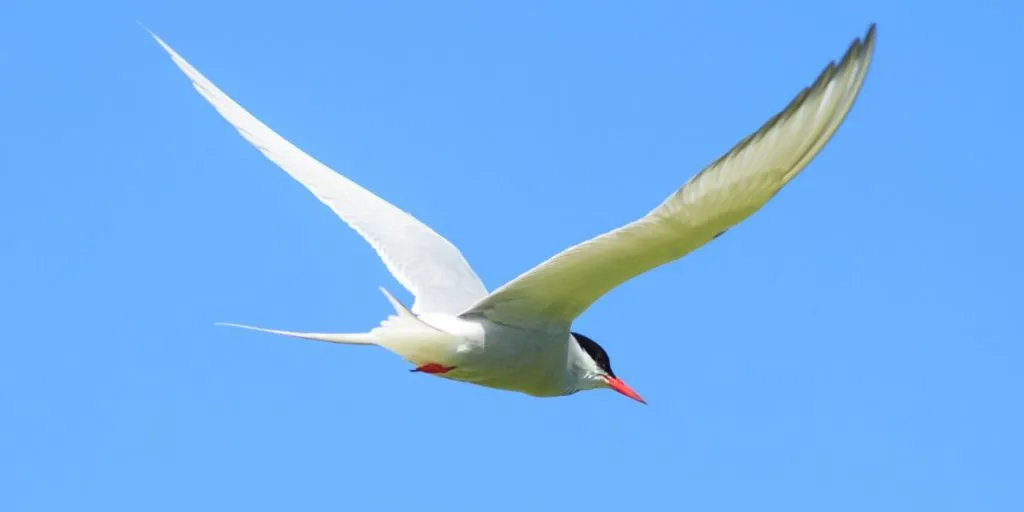
Arctic terns’ wings have a high-aspect ratio which means they are particularly long and narrow wings, perfect for gliding along the wind and using up very little energy over vast distances15 (source: National Geographic).
Their wingspan can range from 25-30 inches (64-76cm) and are lighter than common terns’ wings which have a wingspan of 30-90 inches (77-98cm).
You can get a feel for just how big this is in the image above.
This difference in wingspan is likely due to arctic terns migrating a much further distance than the common tern and therefore requires wings that will not use up as much energy.
12. Arctic terns are preyed upon by foxes, minx, rats, and other seabirds.
Predators such as minx tend to target the arctic terns’ nests. In response, arctic terns are extremely territorial and protective of their nests. They adopt an aggressive approach to protect their eggs or fledglings16 (source: M. Nordström, et al., Biological Conservation, Vol. 109, Issue 3, pp.359-368, 2003).
They will make loud screeching noises and dive-bomb predators with their sharp beaks to deter intrusion. Sometimes, humans interfering with arctic tern nests will also be subject to dive-bombing17 (source: Alaska Department of Fish and Game).
This approach is so often successful that other bird species often nest near arctic terns to benefit from their fierce protection.
However, if predation is too high the arctic terns may abandon their nests altogether.
13. The arctic tern has a shrill, high-pitched call.
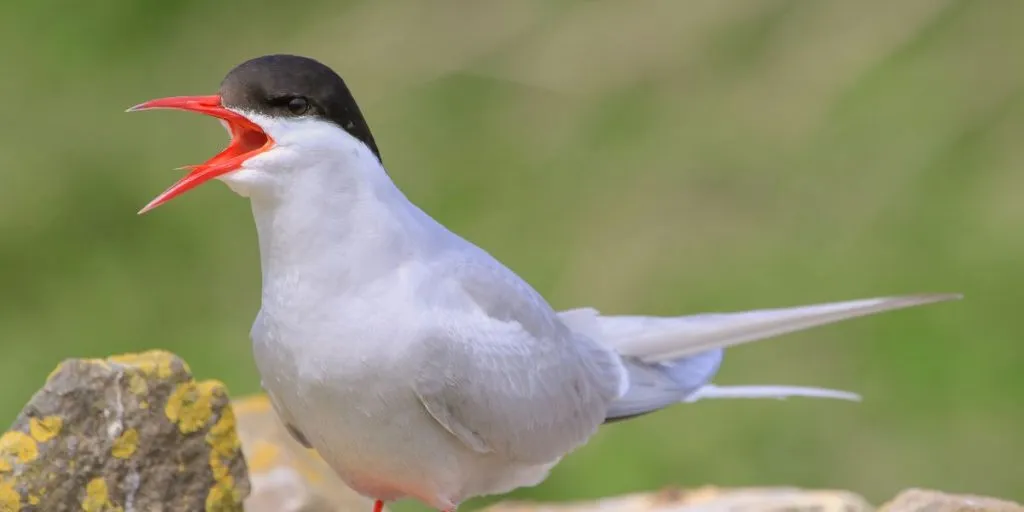
Arctic terns have a boisterous, nasal, and rasping call, not unlike other tern species. Listen to the call here.
This grating call is perfect for deterring predators and humans alike from disturbing their nests and is also used in what is known as ‘fish flight’.
Fish flight is a mating behavior employed by the species. Males will catch a fish in their beak and fly around screeching in order to impress a potential mate. It will land in front of a female tern and offer them the caught fish. If the female is satisfied with the screeching, flapping about and the fish (who wouldn’t be?), they may become a breeding pair.
14. They experience more daylight than any other animal on earth
The timing of the artic terns’ vast migration means that they experience more daylight than any other animal. They migrate towards whichever hemisphere of the globe is tilted towards the sun depending on the time of year.
From May-July the arctic terns will enjoy the northern summer in the Arctic regions, whilst from November-February they will benefit from the southern summer in Antarctica18 (source: C. Egevang, et al., Proceedings of the National Academy of Sciences, Vol. 107, No. 5, pp.2078–2081, 2010).
This results in the arctic terns living in a summer season the whole year-round.
15. There are 2 million arctic terns on Earth.
According to BirdLife International, there are around 2 million arctic terns left in the wild. This number is across a large geographical distribution due to the species’ migratory nature. Conservation efforts, therefore, focus on particularly saturated breeding sites such as Alaska, Iceland, and the UK.
Notably, the arctic tern is not endangered. It was classified as ‘Least Concern’ by the ICUN Red List in 2004 and has remained so since.
However, the ICUN has reported a decreasing population trend. Therefore, their numbers should still be monitored and human activities that exacerbate their decline should be put to an end.
Interestingly, the arctic tern is on the UK’s ‘Amber list’ meaning the UK population is of moderate concern19 (source: RSPB).

16. Global warming threatens arctic tern populations
Global warming is the gradual increase in the overall temperature of the earth caused by the activities of humans.
This increase in temperature results in a decline in plankton available for consumption by sandeels which, in turn, causes sandeel populations to decline.
Sandeels are a vital food source for the arctic terns therefore their decline has a negative effect on arctic tern populations.
The repercussions of this include breeding failures, chick starvation, and clutch abandonment20(source: F.Vigfúsdóttir, Drivers of productivity in a subarctic seabird: Arctic Terns in Iceland, 2012).
Other factors that negatively affect the arctic tern include melting sea ice (as a result of global warming), habitat loss, overfishing, and invasive species such as the American Mink. See our full article to find out more about why arctic terns are endangered.
17. Arctic terns undergo molting in Antarctica
Once arctic terns reach Antarctica in the southern summer months, they will sit on the ice and shed their feathers to allow fresh, stronger feathers to emerge.
During this period, the species is not able to fly very well however Antarctica has little predation, a rich food supply, and a mild climate. Therefore, it is the perfect molting ground for the arctic tern21 (source: National Wildlife Federation).


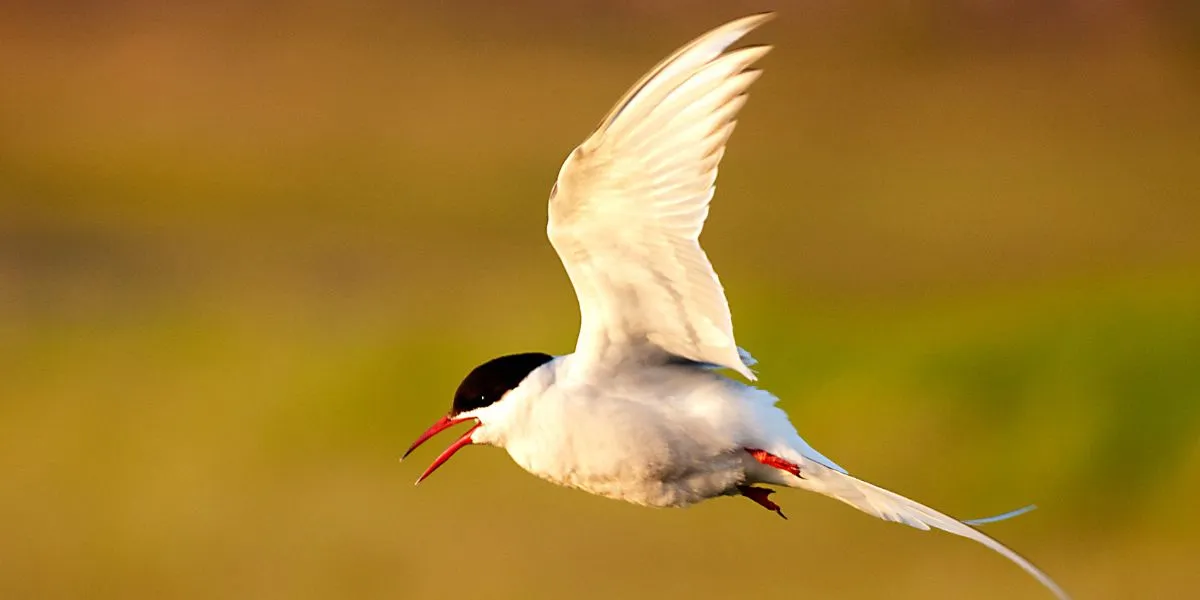
![Read more about the article How Big Is The Arctic Tern [Size + Weight Compared]](https://polarguidebook.com/wp-content/uploads/2022/04/How-big-are-arctic-terns-300x150.jpg)

